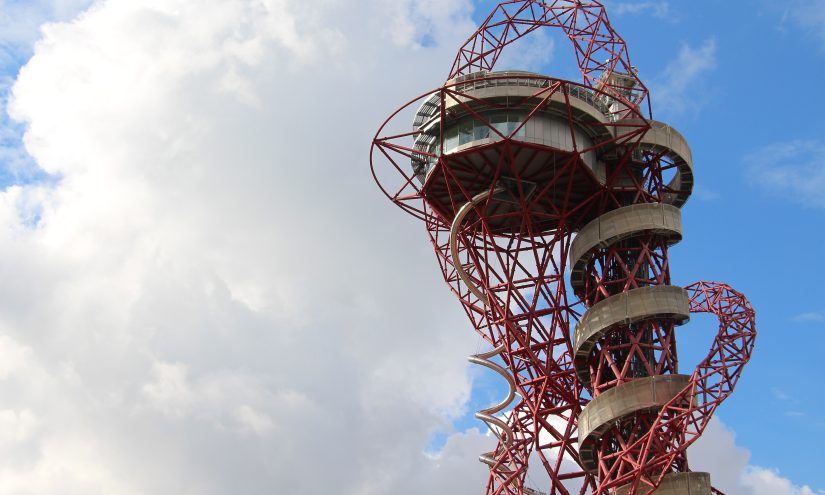


Prefer to listen to this post instead?
The first artwork we visit is a monument most Londoners would be able to recognise. ArcelorMittal Orbit is the UK’s largest piece of public art and a permanent legacy of London’s hosting of the 2012 Olympic Games. The afternoon we walk the trail is hot and hazy, making the usually bright red sculpture a muted silhouette against the sky.
Anish Kapoor, Orbit’s architect, designed the sculpture in a continuing coil, inviting viewers to move around and participate in its constant shifting form. With the colours of Orbit dimmed, I find myself more involved in its winding shape and sheer height. At 115m tall, it has permanently changed London’s skyline and the visual geography of Stratford.
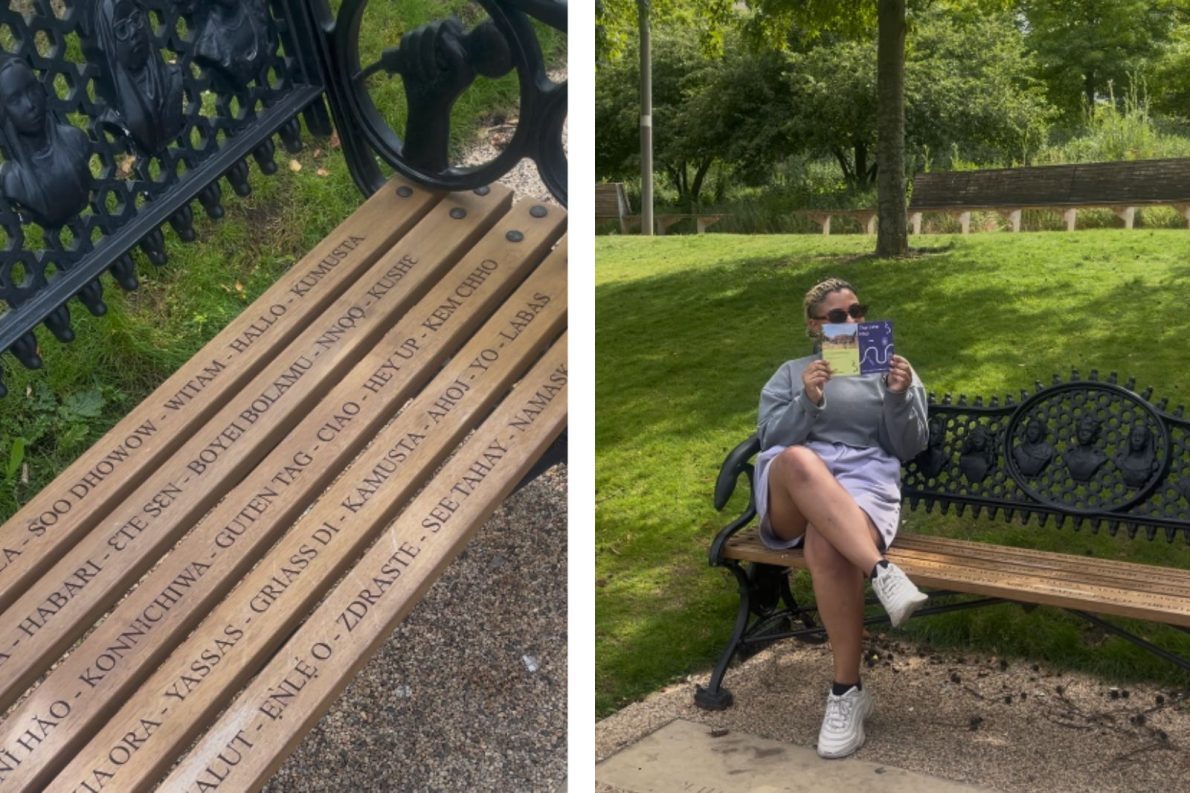
A short walk takes us to Mahtab Hussain’s Please Take a Seat; an intricately engraved Victorian-style park bench made in collaboration with The Line’s Youth Collective. I love how the trail takes you from the UK’s tallest sculpture to a humble park bench. It’s an instant reminder that art can take any form to be impactful.
After a brief chat with The Line’s team, who happened to be running one of their weekly wellbeing walks, Arlowe and I get the chance to take a closer look at the artwork. A first glance immediately distinguishes this bench from the others that populate the Olympic Park. Its iron workings feature references to the working-class community of East London; jellied eels, the Bow Bells and a microphone to represent Newham’s association with grime music.
An engraving below the bench reads ‘Hello, let’s make a portrait together’, inviting park-goers to take a picture and share it as part of a collaborative portrait of East London. It’s evident in this piece that community and culture matter deeply to Hussain. Transforming a mundane piece of civic life into a spontaneous interaction with the environment pushes the boundaries of public art in a playful and insightful way.
As I read inscribed greetings in dozens of languages, I wonder how many people will learn the origins of jellied eels and grime through this piece. Not being from Newham, I learn a piece of London folklore: only those born within the sounding range of the Bow Bells are considered true Cockneys. As someone born in Brixton I don’t quite make the cut, but as The Line leads us to our next artwork by an East Ham native, I find myself endlessly captivated by the cultures of London and how they enrich every inch of the city.
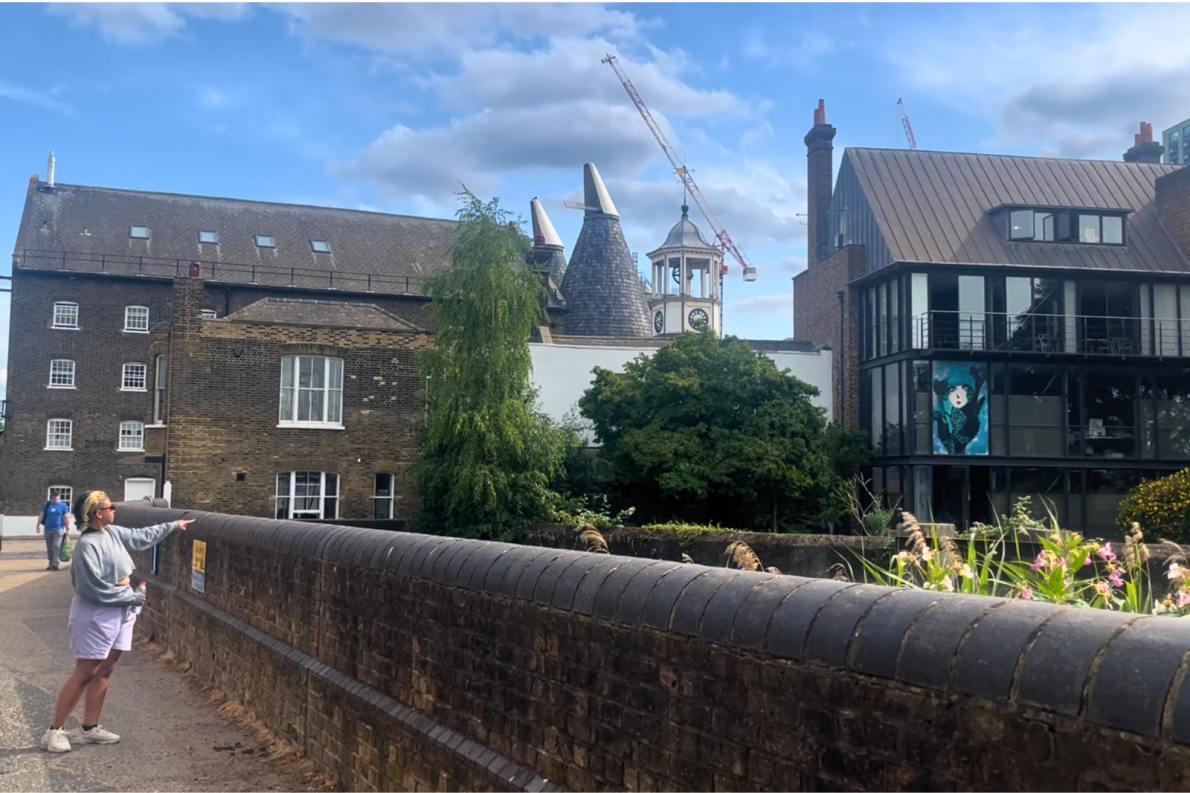
Following the path along the canal takes us to the first in Madge Gill’s Nature in Mind series, curated by Sophie Dutton. Gill’s story draws me in instantly, with her being a self-taught artist from the 20th century whose life was disjointed and suffused with personal tragedy. These experiences led her to spiritualism and eventually an extended art practice of ink drawings, embroideries, knitting and crochet-work.
A female figure features prominently in many of her artworks, greeting Arlowe and I with her passive gaze as we approach. Gill’s use of intricate patterns and repetitive motifs adds a sense of depth and mystery to her pieces, inviting viewers to contemplate the meaning behind each detail. The serene yet haunting presence of the female figure in her works reflects Gill’s own inner struggles and search for connection within the spiritual realm.
Having Nature in Mind overlook the canal feels poignant and purposeful. Gill’s feminine figure takes the role of a sentinel, peacefully viewing the wildlife populate the waterways and the trees changing with the seasons.
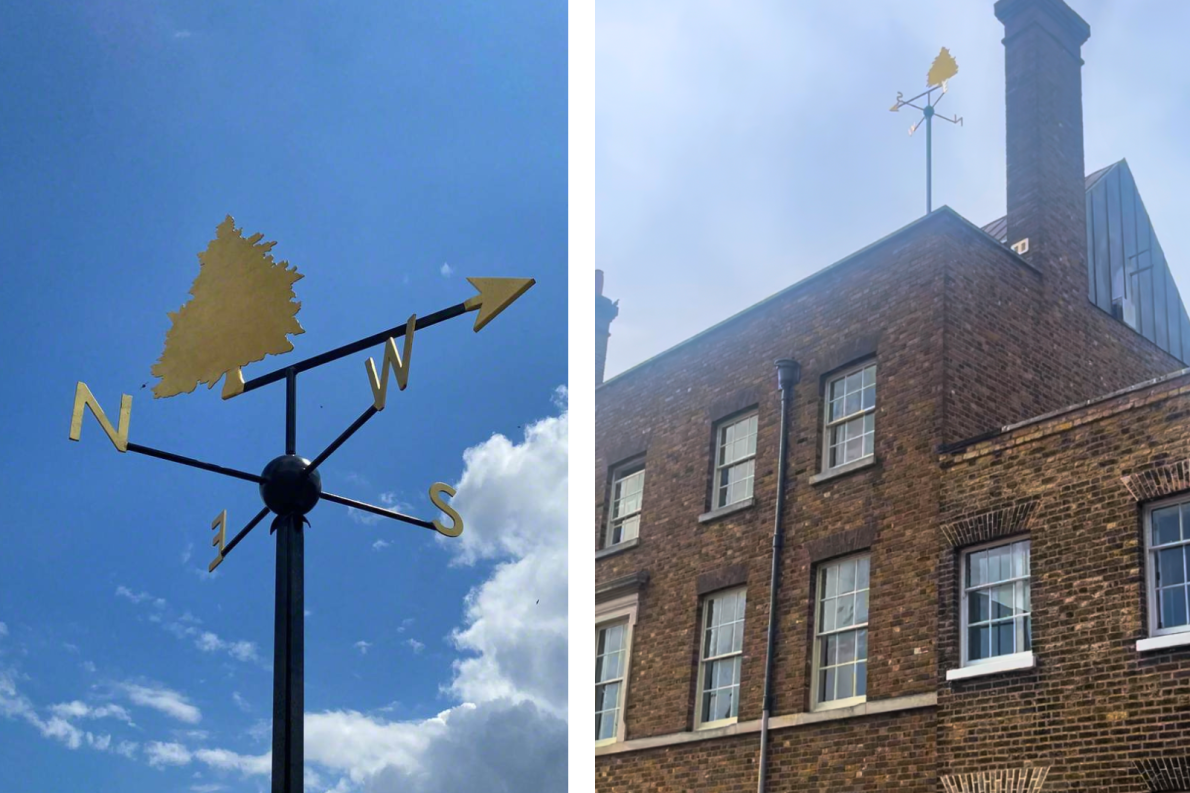
Turning a corner takes us to Virginia Overton’s weathervane, inspired by the juniper trees of her southern U.S. hometown. Overton’s work spans large scale installation, sculpture and photography, so seeing her take on a simple weathervane feels significant.
When your phone can predict minute changes in temperature, pressure and wind, one might wonder why many buildings across London still host weathervanes on their shingled roofs. Yet simply turning your gaze upwards can give clues to the original purpose of a building and further immerse you into the intricate histories of London. From Untitled, I learn the building it occupies was once a grain mill and distillery that produced gin at the height of London’s gin craze of the 18th and 19th centuries. The ornamental feature of the weathervane is a juniper tree which produces berries, often used to flavour gin.
By the time we’re viewing Overton’s piece, it’s been over an hour since we started our walk and the weather hasn’t changed much. Though the sky is bright and blue, it’s littered with thick white clouds that obscure the sun. As we stand underneath, Untitled slowly starts to spin. Wind parts the clouds in the sky and unveils the sun.
As if on cue, sunlight catches and reflects the golden tree. I have no idea how to read a weathervane but find myself unable to tear my eyes away from the glittering ornament. The wind shifts again and so, Untitled spins. The sun becomes covered in a blanket of soft white clouds and our light show is over.
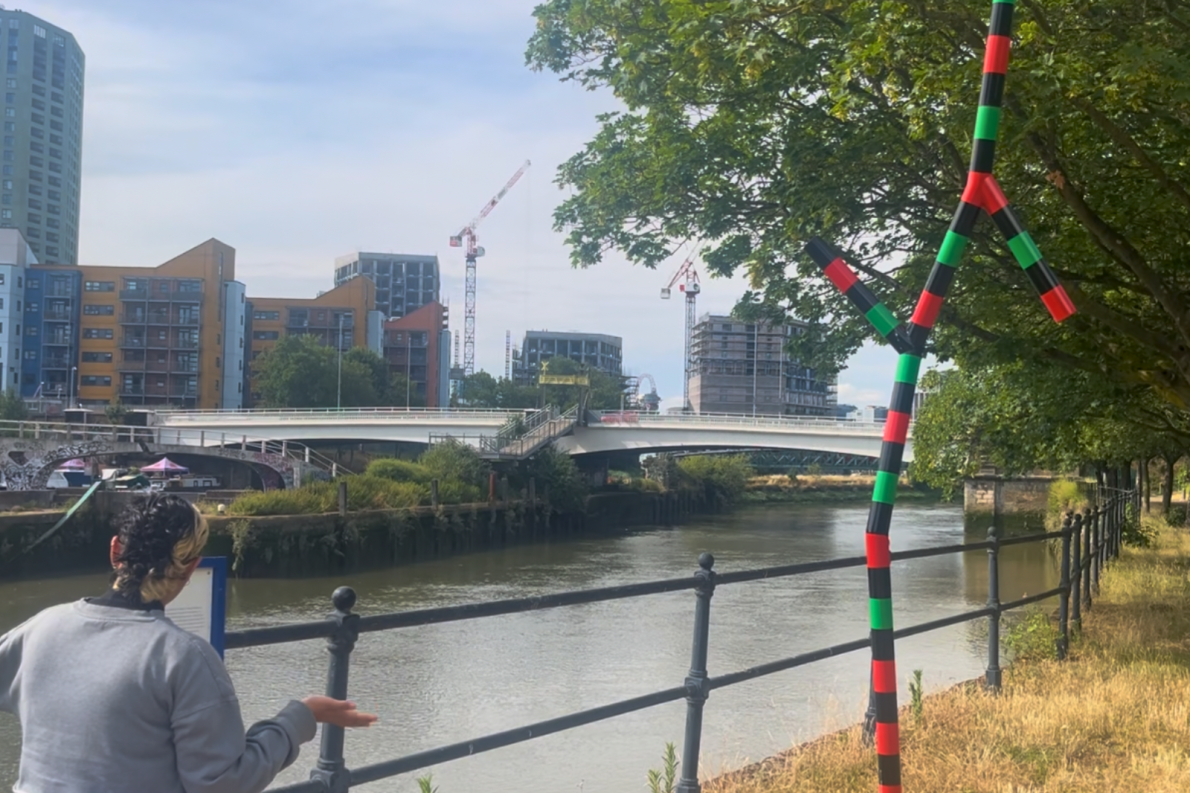
Eva Rothschild’s Living Spring gently appears from a line of verdant and mature trees, with the silver towers of Canary Wharf in the background. Although a slender sculpture, Living Spring makes itself known with a pattern of red and green as complementary colours, interrupted by blocks of black. Rothschild has stated she is not concerned with imposing meaning with her works but on bringing disparate works together as though in conversation.
It’s clear with its placement that the artwork is meant to play off the natural environment and enhance the seemingly ordinary line of mature trees into an ongoing art piece that evolves over the seasons. The experience of viewing the piece in the height of summer will be drastically different to a viewing in the depths of winter, when the bare trees will better mirror Living Spring.
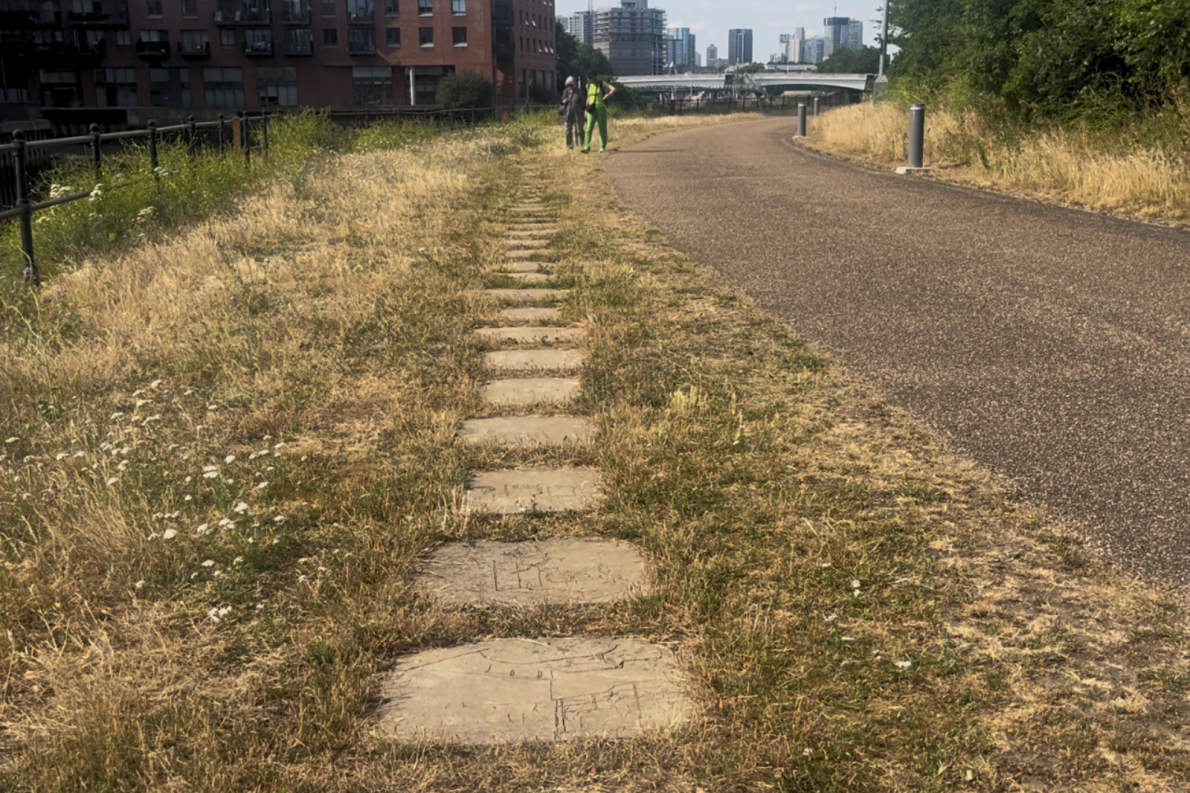
A short walk down the riverway takes us to Simon Faithfull’s chronicle across continents, 0º00 Navigation. 38 unassuming paving stones are engraved with drawings made by the artist as he travelled south along the Greenwich Meridian through Europe, North and West Africa. The journey started on the north coast of France before proceeding through Spain, Algeria, Burkina Faso, Togo and ending on the southern coast of Ghana.
Faithfull’s drawings are simple but impactful, detailing intimate snapshots of the everyday. The online guide directs me to a document with Faithfull’s notes across the meridian. They are helpfully numbered, giving context to the paving stones.
I spend the most time at this artwork, intrigued by Faithfull’s insights as a traveller and artist.
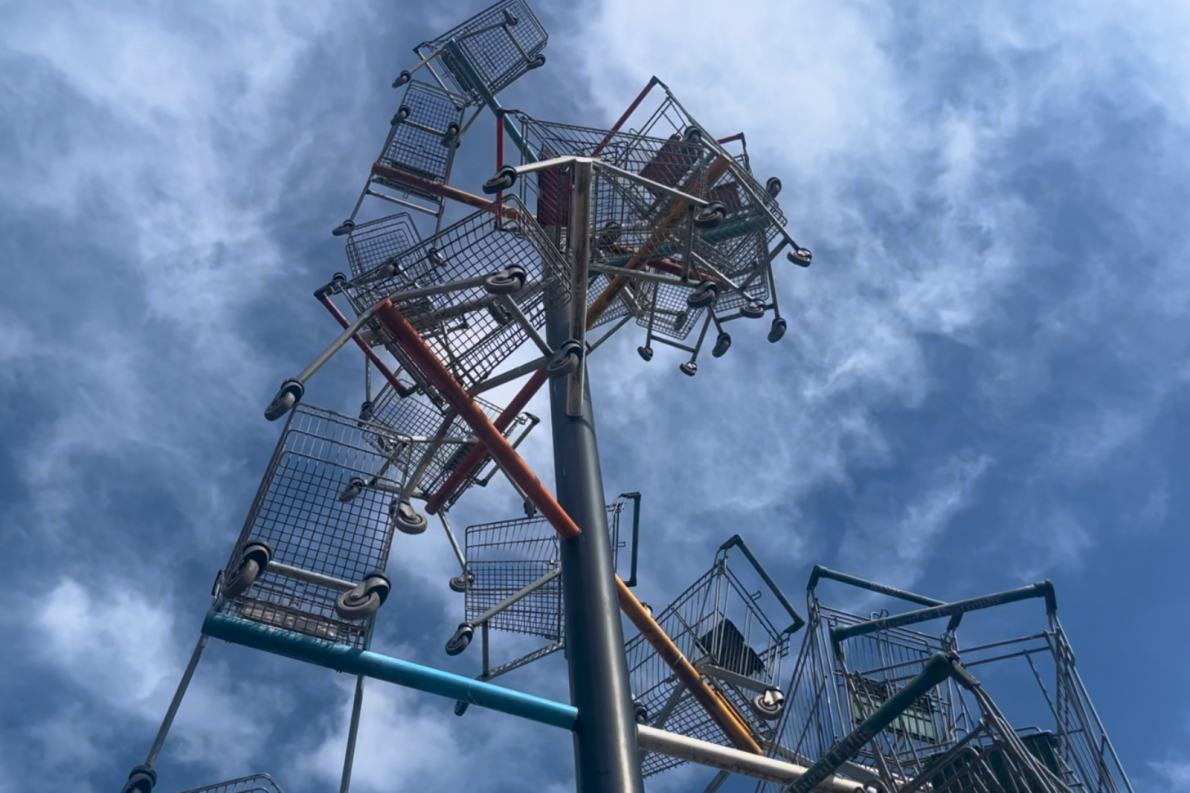
The Line features pre-existing and new artworks from a mix of both British and international artists. Abigail Fallis’ DNA DL90 is a critique on modern society’s consumer culture and a commemoration of the 50th anniversary of the discovery of DNA’s structure. 22 shopping trolleys stacked in the shape of a double helix make up this eye-catching sculpture.
Though over two decades old, Fallis’ commentary on consumption could not be more relevant to the modern day. I’m reminded of the times I’ve previously visited a sombre exhibit, to then be bombarded with trinkets and collectables to purchase at absurd prices.
Free from a gift shop awaiting me around the corner, I appreciate DNA DL90 serenely.
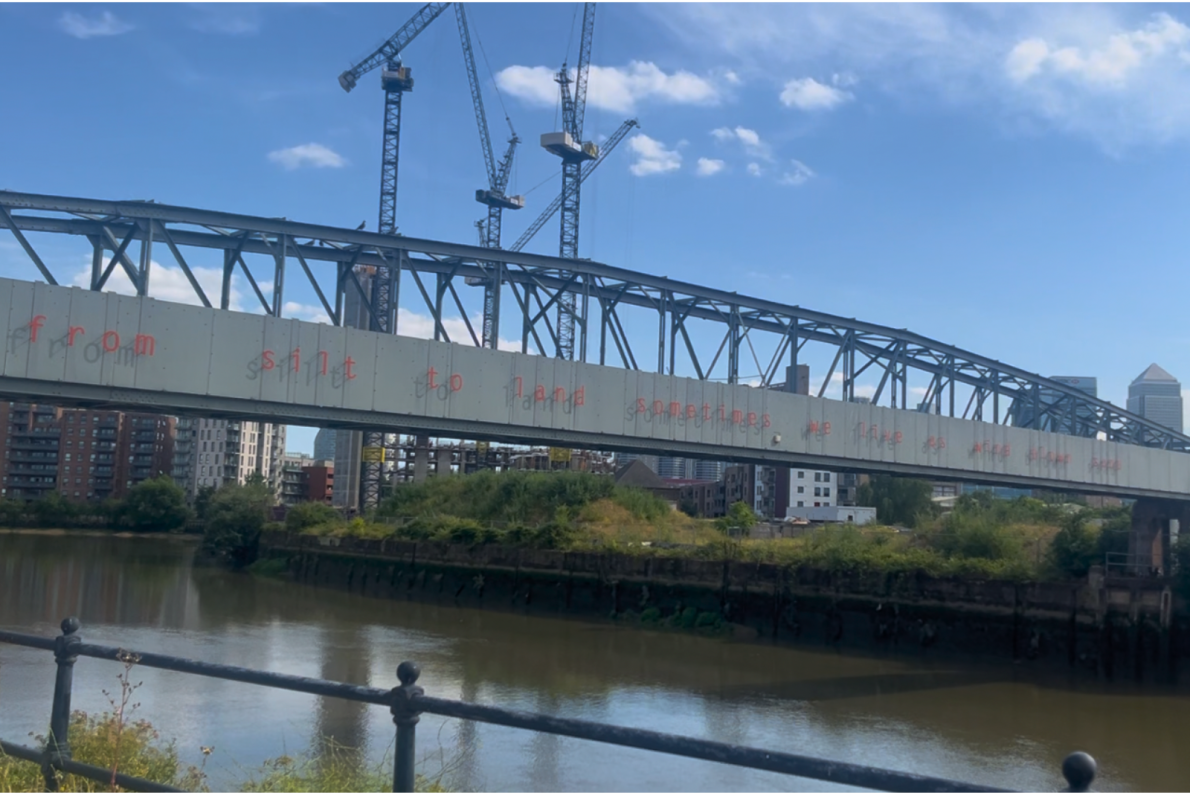
Our last piece of the day is Helen Cammock’s On WindTides, a co-commission made in collaboration with local residents. The artwork consists of two works of prose, spanning a bridge that crosses the River Lea. One side of the bridge reads ‘we fold ourselves across the tides,’ whilst the other reads ‘from silt to land sometimes we live as wind blown sand’. Cammock’s prose references the development of Cody Dock and East London in general. What was once warehouses and depots is now apartments and restaurants, fostering community and contributing to the regeneration of this side of London. Movement is a natural and fundamental part of human existence which On WindTides mirrors beautifully, with the steel letters of prose creating shadows with the movement of the sun.
Overall, it took about 1 hour 45 minutes to complete just under half of The Line. Whilst it was a wonderful way to spend the hottest day of the year, I would recommend others to walk The Line in less extreme weather!